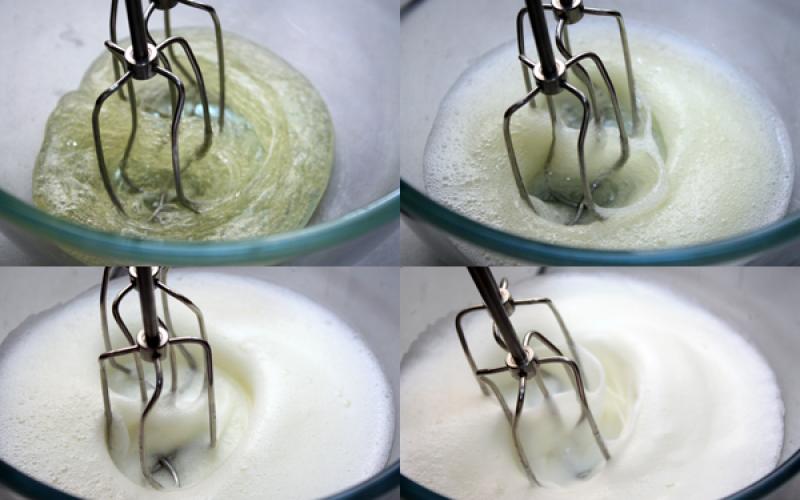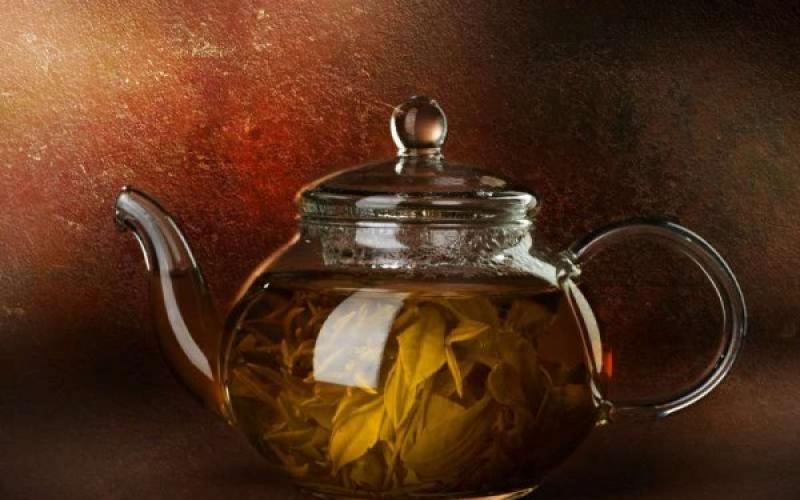The more often you cook and communicate with different people on culinary topics, the more you realize that for many there are like enchanted recipes. It doesn't work at all. This applies primarily to yeast dough and whipped proteins. Both are quite simple, but there are some subtleties.
Despite the fact that we have already raised the topic, many still have questions. Therefore, I decided to fundamentally cover this topic, so that later I could refer to it when questions arise.
And with step-by-step photos we already have.
So first a few tips:
1. How to choose and prepare a bowl for whipping egg whites
Copper utensils are ideal for whipping, as they produce the most lush and steep foam that will last a long time. Copper utensils are not so common in our everyday life, so it is best to replace them with glass or metal ones. But it is better not to use plastic dishes for whipping, because greasy films form on its porous surface, which prevent proteins from reaching their maximum volume. Aluminum containers are also not very suitable, as this metal will react with any acid added to the proteins, and the mass will turn gray.
So we use copper, glass or metal utensils for beating egg whites.
The preparation of the whipping utensil consists primarily of making sure that it is absolutely clean and dry. Any, even the most minimal amount of fat can lead to the fact that the proteins will rise only by a third of the potential volume. This is because fat interferes with the formation of protein bonds in the protein foam.
It is often recommended to rub bowls and whisks with lemon juice before whipping, and then pat dry. But I always have enough just clean and dry dishes.
2. How to choose eggs and prepare egg whites for whipping
You can beat almost any egg, but keep in mind that the freshest eggs will take a little longer to beat due to the fact that they have a very thick protein. But they last longer in a whipped state.
Many people advise to beat cold eggs, but this only complicates the process. Eggs are much easier to beat room temperature, since warm proteins have less surface tension and bubbles form in them more easily.
3. Stages of whipping egg whites
Often, recipes indicate to what state the proteins need to be whipped - into foam, to the state of soft or hard peaks. Now I want to describe in detail what it is.
- Foam. This is the state when the proteins have already become frothy, but remain liquid. At the same time, there are rather large bubbles on their surface, and the foam does not hold its shape when you remove the beaters from it.
-Soft peaks. The foam becomes wet and white. When you take out the beaters, the proteins take the form of rounded peaks and then settle down.
-Solid peaks. At this stage, the foam retains its whiteness and luster and does not run if you tilt the bowl. If you take out the whisk, the foam will follow it and take the form of sharp peaks. At this stage, the proteins reach their maximum volume.
- Over-beaten egg whites. This stage is most often reached by those who use an automatic mixer. Proteins become dry and grainy. To remedy the situation, you will have to add more fresh protein and beat to the stage of a shiny foam of the desired consistency.
4. How to make beaten egg whites firmer and prevent falling off
To give stability to beaten egg whites, acid is added to them - lemon juice, vinegar or cream of tartar. The acid helps bind the protein cells, so the proteins whip up faster, become more uniform and hold their shape longer.
By the way, it is better to add acid at the foam stage (see above).
If you add sugar to the proteins, the mass will become very dense and very stable. How to add sugar, you will see below.
5. How to correctly introduce egg whites into the dough
If you need to introduce egg whites into the dough, for this you need to take a large spatula (preferably rubber or silicone) or use a whisk. The whisk, by the way, will help you do this faster, because it has more surfaces that will help push the dough apart and penetrate the proteins into it.
You need to shift the proteins carefully, making as few movements as possible so as not to destroy the bubbles.
First, it is best to put 1/4 of the proteins into the dough, gently mixing from the bottom to the top in one direction, this will help make the dough softer and airy and make it easier to introduce the rest of the proteins. When this part of the proteins is mixed with the dough, the rest of the mass must be mixed in the same way.
6. How to properly add sugar to proteins. An experiment in pictures.
First, the correct way.
We take the proteins, we begin to beat them slowly, gradually increasing the speed, achieving a state of soft or hard peaks.

It will go something like this.
When we reach the desired state, little by little (1-2 tablespoons) add sugar or powdered sugar. The powder dissolves more easily and the desired consistency is obtained faster.

In a few minutes, we will have what we wanted - a dense, smooth and stable mass that can be used for its intended purpose.

Here is such.
What happens if we just put sugar in the proteins right away?
And here's what:
We put the proteins in the right clean bowl, add all the sugar there, even dripping citric acid so that the mass is elastic and stable, and beat very patiently.

You can see it on the pictures. how the mass turns white and even increases in volume. But now let's try to take out the mixer...

Oops... But nothing is holding. As the mass was liquid, it remained.
As they say, follow the technology, dear chefs!
I really hope that this post will help everyone who wants to properly handle egg whites.
1. Choose clean dishes. Mixer attachments should be clean, wash them well if you have beaten something before. Do not use plastic utensils, they easily form a greasy coating.
Ideally, the whisking bowl should have a round bottom so that the mass does not accumulate in the corners and beat evenly. Remember that when whipping, proteins increase very much in volume, so take a large bowl, 8-10 times more than the volume of unwhipped proteins.
Wipe the whisking bowl with a slice of lemon (I never do this), theoretically this removes foreign matter that could interfere with whipping.
2. Check which mixer you have - the attachments should look something like the picture. For hand whipping, you can use a whisk or a fork.
Whipping blender is not suitable!
3. The duration of whipping depends on the amount of proteins and the depth of the dish. Do not take a lot of proteins - two will be enough!
4. To separate the whites from the yolks, beat the egg with a knife, break it in half and pour the yolk from one shell to another over a cup. The protein will drain into the cup, and the yolk will remain in the shell.
Do this over a separate bowl each time, then pour the egg white into a large bowl. Then, if suddenly the yolk gets into the protein, the rest of the proteins will remain clean.
Remember that the presence of yolk in the whites will make whipping very difficult, the whites will whip poorly or not at all!
(But in fairness, I’ll say that more than once I managed to beat egg whites well and with a small amount of yolk, apparently, it all depends on the proportion.)
5. Pour sugar into a cup and place next to the protein bowl. Sugar should be small, then the crystals will dissolve faster.
6. Turn on the mixer at maximum speed and beat the whites for 1-2 minutes, it will not take more than two minutes (when beating two proteins). The mass should become white, dense, when you take out the nozzles - clear traces remain. If you let it stand, it will settle a little, but this is not necessary (although you can always beat again).
7. I add sugar right away!! Do not persuade me that you need to pour it in a thin stream. If the sugar is small, it will dissolve well. Poured in? We continue to beat at maximum speed, usually at least 2-3 minutes. The mass will become dense, viscous, the nozzles do not just leave a mark, but draw out dense peaks that hold on and do not fall off. The mass becomes shiny and bright white. You should not beat for more than 5 minutes, as you can over-beat, then the proteins can separate into liquid and white flakes.
Use the mass immediately, do not leave! By the end of whipping, everything should be ready - the oven is heated and a baking sheet is laid.
Depending on the purpose for which you whip the proteins, they can be whipped in different ways.
For meringue, I take a proportion of 50 g of sugar per egg white and beat according to the above technology.
If you are whipping egg whites for a biscuit or other airy dough, it is important to stop in time - the mass should be dense enough, the nozzles should leave a mark, after adding sugar a shine should appear, but do not beat for a long time - it is important that the air bubbles remain large enough and with dense walls , which then expand in the oven from heat, but do not burst.
For some products, it is necessary to whip the egg whites even lighter so that only soft peaks are obtained, pay attention to such directions in the recipe.
I don't know how else to help those who can't! At school, I also, I remember, didn’t succeed, as it turned out, I didn’t whisk well enough. This, I think, is the main problem.
And yet - the time indicated by me, apparently, depends on the power of the mixer. In any case, you should focus not on time, but on the result, especially if you beat by hand.
Good luck!
It often happens that after cooking some dishes or baking, the hostess has egg white left. What to do with it and can it be used after a while? This article explains how to store leftover eggs and for how long.
What is egg white used for?
When preparing pastries or desserts, some recipes use only the yolk, while the whites remain and can be used to make various cakes, creams, meringues, pies, other desserts, omelettes and other dishes. But for this you need to know the rules and conditions of storage.
How to store if there is no refrigerator?
Raw proteins can not be stored at room temperature for a long time, otherwise they will dry out and deteriorate. If the preparation of proteins is planned in a couple of hours, then you can leave them under such conditions in a plastic container with a tightly closed lid and in a dark place. It is also permissible to lower it into the cellar if its temperature conditions are not more than +6 degrees and store it in a closed container for 1-3 days.
Cold storage
Egg whites are well stored in the refrigerator at a temperature of 2-4 degrees for no more than 5 days. The door of the refrigerator compartment is not suitable for the location of this product, as the temperature in this place is higher. It is better to place the squirrels on the very top shelf.
Storage containers must be clean and tightly closed. Plastic containers will do.
in the freezer
Egg whites last the longest in the freezer. The duration of suitability without loss of valuable qualities will be from several months to six months.
Freeze the product in plastic containers or in an ice mold. After complete freezing, it is worth transferring to a regular plastic bag and continuing storage.
IMPORTANT: Egg white is allowed to be thawed once. If re-frozen, the product will lose its properties.
It is necessary to sign how many proteins are frozen, and put the date on the label.
How to store whipped egg whites?
Whipped proteins in cooking are usually used immediately, as the foam quickly falls off. Of course, it is possible to freeze the foam, but when defrosted, it will no longer be whipped protein.
Whipped protein with sugar can be kept in the refrigerator for a couple of hours, but there is no guarantee that it will be preserved in the required form. You need to put it in the same bowl in which it was beaten, and cover with a lid.
boiled
The temperature at which boiled proteins can be stored in the refrigerator for about three days is 2-4 degrees. At the same time, it is best to place them in a plastic food container with a tight-fitting lid.
You can try to freeze boiled protein, and it will not deteriorate for about six months, but when defrosted, it may lose its taste.
Dry proteins
Dehydrated egg white (albumin) is used in the same recipes as the regular one. But it is stored much longer than raw. The opened package is placed in a dark, dry place, and the product will be suitable at room temperature for about a year. Sealed packaging will keep for several years.
Egg protein is a very valuable product that is widely used in cooking. It can be stored in various convenient ways, without losing the quality of its composition and nutritional properties. But for this you need to know the storage conditions.
I found frozen yolks in the refrigerator (remained after cooking the meringue). Thawed, and they became a jelly-like consistency. I wondered if they could be used like that and where? ..
It turned out, CAN!!! When frozen, the yolks, as well as proteins, perfectly retain their original properties. It doesn't work that way with squirrels. The yolks, yes, become dense and look like jelly. However, this does not prevent them from being used in dough or, for example, for making cream. True, it is unlikely that it will be possible to beat thawed yolks (as, for example, for). If the dense consistency is embarrassing, you can mix them with sugar before freezing (10% by weight of the yolks).
EGG SHELF LIFE
The question immediately arose:
How long can egg yolks/whites be kept in the refrigerator if you don't want to freeze them?
Shelf life raw eggs in shell - 28-30 days. without shell yolks stored 3-4 days, proteins - up to 5 days. At the same time, storage is strictly in the refrigerator and in a hermetically sealed container, since they can simply dry out. Welded vrku Thuyu eggs can be stored in the refrigerator for up to 7 days, and at room temperature for no more than 12 hours.
The shelf life of raw eggs starts from the moment the hen lays the egg. And it takes time for packaging, packaging, logistics to the store. With eggs in the package, everything is clear - see the date of production. And if we buy eggs in the market?
How to check the freshness of eggs at home?
Drop the egg into a glass of cold water. If it "lies" horizontally on the bottom, it means it's fresh. If it descends in an inclined position, as if diagonally, it is more than a week old. And if it "stands" vertically in the water or, even worse, remains floating on the surface, it means that its expiration date has already expired, and you can’t eat such eggs!
There is a simple logical explanation for this method of verification.
The figure shows what an egg consists of. 
The egg shell has a porous structure, which means it is able to pass odors, gases and moisture. Protein is 90% water. Over time, the water evaporates, the egg under the shell decreases in volume, making room for the air chamber. The longer the egg was stored, the larger its air chamber. Therefore, if the egg is old, the enlarged air chamber keeps it on the surface of the water in the glass. Got it sorted out.
EGG WEIGHT
Now another question that has been bothering me for a long time. In many culinary textbooks, the number of eggs is indicated not in pieces, but in grams. It is correct, of course. Still, today the chicken tried and laid a large egg, tomorrow she changed her mind, or she lost her mood (a chicken is a woman, but women tend to). And grams are an inanimate unit, they are not subject to weather and other human ones. Therefore, scales help everyone! But anyway...
the weight whole egg(without shell) - 50 gr,
yolk
weighs 20 gr,
protein weighs 30 gr.
And about the most important...
HOW EGGS WORK IN BAKING
First, along with flour, eggs form the structure
.
Under the influence of heat, the proteins (proteins) that are contained in the egg connect, forming a strong network. This process is called the terrible word coagulation. The most obvious example is boiled eggs. The water heats up, the eggs begin to coagulate, i.e. harden. It is the process of coagulation that underlies the preparation of the famous - its structure is formed by eggs. And when we boil or sabayon sauce, we heat the yolks with sugar and liquid (milk, wine) and wait for the mixture to thicken - and this is also a coagulation process.
Secondly, Eggs have the unique ability to take in air and retain it.
.
This feature of eggs is extremely important when baking biscuits. Beaten into a dense foam, the eggs help the air to penetrate the dough. And air is the baking powder, which has the most powerful lifting force. Therefore, how well the eggs were beaten directly depends on whether the biscuit will rise.
Thirdly, eggs help to combine the ingredients
.
So egg yolks act as emulsifiers (another terrible word), i.e. help to mix immiscible substances such as fat and water. To bake muffins, we need to separately combine all liquid ingredients: for example, vegetable oil and kefir. If we do not add the egg yolk, the mixture will separate: puddles of oil will remain floating on the surface of the kefir. And as soon as we add, all the ingredients will combine into a homogeneous emulsion.
In addition, if the dough contains a large amount of additives (dried fruits, nuts, spices, seeds), then it is thanks to eggs that these additives stick together with the baked product. As a result, the finished product holds its shape, and does not fall apart into pieces.
Fourth, eggs make baked goods softer and more crumbly.
Although the eggs
contribute to the formation of the structure of the dough, yet egg fats, emulsifiers and proteins prevent the formation of gluten in raw dough.
So, for example, in the dough for baguettes, where the development of strong gluten is extremely important, eggs are not added at all. And in the dough for brioches (French buns), eggs are introduced only after the main batch, when good gluten has already formed.
These are the most important functions of eggs. There is also moisturizing the dough (eggs are 75% liquid), the effect on the color, taste and appearance (surface gloss) of the finished baking, but this is all secondary.
Enough about the eggs.
To whip a dense, thick and persistent protein foam, it is important to choose the right dishes. It is best to use a small enamel saucepan or deep bowl made of glass, stainless steel or ceramic. It is believed that proteins are best whipped in copper utensils, but bowls and pans made of copper are a rarity in modern kitchens. Do not beat egg whites in an aluminum bowl, otherwise the cream will acquire a grayish tint. Food-grade plastic is also not suitable - the thinnest fatty film may be present on its surface, and the ingress of fat into proteins will prevent them from turning into lush foam. That is why the dishes in which the cream is prepared must be perfectly clean and completely dry.
Despite popular belief that egg whites are best refrigerated before whipping, it is still advisable to use room temperature products. Chilled proteins whip faster, but give less high and persistent foam. It is necessary to use only fresh eggs - long-term storage worsens their taste, in addition, the whites of long-stored eggs do not beat well.
Whipping should be started at low speed, with uniform movements of the mixer or whisk. As white foam appears, the speed can be increased. It is important to beat the entire volume of the product - so that no liquid protein remains at the bottom of the cup or pan.
When the mass has increased by about three times, you can add a pinch of salt or a drop of citric acid or lemon juice (no more than a quarter teaspoon of salt or acid for 4 proteins). This will speed up the whipping process and help the protein mass retain its shape.
Sugar or icing sugar should be added when the whites are already whipped into a soft, thick foam, and poured into the whites little by little, without ceasing to beat - if you pour everything at once, the mass will become liquid and stop holding its shape. One protein requires at least two tablespoons of sugar or powder, while adding no more than half a teaspoon at a time. It is better to use fine sugar, without lumps, and it is advisable to sift the powder before adding it to the proteins.
Properly whipped sugar-protein mass increases in volume by 4-5 times, looks dense, uniform and shiny and forms stable "peaks" - when lifting the whisk, a sharp, non-falling "tail" should follow it. When rubbing a small amount of foam in the fingers, grains of sugar should not be felt - otherwise, beating should be continued until the crystals are completely dissolved. You can check if the foam is well whipped by turning the bowl over - if everything is done correctly, the foam will not start to flow down.








